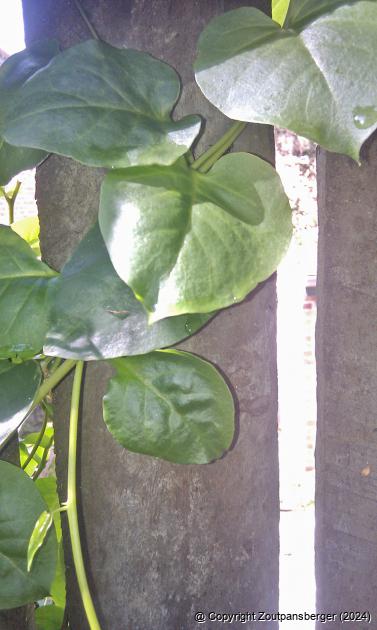

ADVERTISEMENT:

A close-up of the fleshy, waxy-green heart-shaped leaves of the Madeira vine. Photo: Wikipedia.
Heart-shaped invader set to change the natural world as we know it
Date: 07 July 2016 By: Isabel Venter
You may have a very aggressive little green alien in your garden, and you may be totally unaware of its existence.
No, not the kind of alien that comes from outer space, but rather the multi-stemmed evergreen climber kind with fleshy, waxy-green heart-shaped leaves. The Madeira Vine (Anredera cordifolia) was once valued as an ornamental plant, but in recent years has turned into a nasty sight in South Africa, and in particular in the Soutpansberg.
Gail Maytham, who operates a guest house from her farm Zvakanaka, has had a 16 year-long battle with this horrible creeper. She only recently discovered the name of the plant and did some further study on it. “When we arrived here [on the farm] it smothered many trees and, over the last 16 years, we have consistently and religiously pulled it out of the ground, dragged it from the tree canopy and burned it,” said Gail. A few months ago, a team of academics from the Netherlands visited Gail’s farm. One of them was a professor who specialises in invasive alien plants, and he identified the creeper vine.
The Madeira vine is like the proverbial honey badger; the tiniest bit of leaf or part of a tuber that falls to the ground will quickly grow into a luscious bush again. If the plant takes a tree as host, it will eventually kill it by shutting it off from the light. “It is all over Louis Trichardt, and I was horrified to see that a friend of mine had even recently planted it because it grows so quickly, and it is decorative. When I showed my horror, she promised to remove it,” said Gail.
The Madeira vine, better known as the mignonette vine or lamb’s tail, is native to Paraguay, southern Brazil and northern Argentina. It is an aggressive, multi-stemmed evergreen climber with fleshy, waxy-green heart-shaped leaves and greenish white flowers arranged along a flowering spike that has crept is way all over South Africa - not just Louis Trichardt.
The Madeira vine has been classified as an NEM:BA Category 1b species, signifying the major risks that it holds for indigenous plants. Dispersal is predominantly vegetative, as aerial tubers borne along stems are dropped from the canopy. Where the Madeira is found along water courses, these tubers can be carried over long distances.
SanParks recently completed its first species-specific strategic management plan in an attempt to manage the spread of Madeiras. The aim of the new strategy is to identify the best methods for the monitoring and control of the Madeira vine within and adjacent to national parks and to prevent it from spreading. The first step in the process is to map all known populations, which is done with the help of the online citizens’ research website iSpot.
This site encourages ordinary citizens to gather information about their environment and log it with iSpot’s various online databases. This data has produced various surveys for public participation and assists with further research projects across South Africa.
Louis Trichardt residents can assist in SanPark’s project by removing Madeira veins from their gardens, or report where they have spotted a vine.
A sighting can be logged at www.ispotnature.org/projects/spot-madeira-vine-garden-route or by writing an email to [email protected].
Viewed: 1034
|
|
Tweet |

-

Former Triegie’s acting career taking off
12 April 2024 By Karla van Zyl -

'Temporary fix is safe, but do not touch cables,' says municipality
12 April 2024 By Andries van Zyl -

Another R2 million pumped into broken pool
12 April 2024 By Andries van Zyl -

Louis Trichardt se rugbymanne wys reeds vroeg in die seisoen tande
12 April 2024 By Andries van Zyl -

Havinga waarsku teen koue en droë winter
11 April 2024 By Andries van Zyl

Isabel Venter
Isabel joined the Zoutpansberger and Limpopo Mirror in 2009 as a reporter. She holds a BA Degree in Communication Sciences from the University of South Africa. Her beat is mainly crime and court reporting.

More photos...

ADVERTISEMENT


-

Park development leaves residents puzzled
22 March 2024 By Andries van Zyl -

Local para-athletes shine at SA Champs
05 April 2024 -

Epic finish for local cycling duo
29 March 2024 By Andries van Zyl -

What next Vhembe!
22 March 2024 By Andries van Zyl -

Debt-collection company apologises for rude letter
29 March 2024 By Anton van Zyl

ADVERTISEMENT:


ADVERTISEMENT



